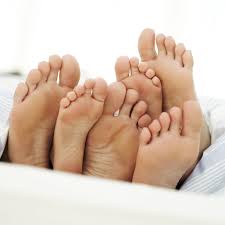How do your feet feel by the end of the day?
The feet can determine much of what is happening in the rest of the body. Let's look at some of the dis-eases that occur in the foot.
There are fallen arches, high arches, ankles that are shifted in most cases toward the middle of the body, bunions, hammer toes, supination (walking on the outside of the foot) or pronation (walking on the inside of the foot), neuromas, broken bones, plantar fasciitis, strains, and strains.
All of these can and will affect how the foot hits the ground as you walk. Injuries to the foot can bring about compensations that will be felt higher up the line of the body. These can include rotation of the hips or the leg itself, what appears to be a shorten leg, rib shifts or rotations, shoulder rotations, jaw discomfort, or a tilted head, to name a few.
A goal of structural intergration is to give the body a sound base from which to move. As part of a session, the feet, along with the rest of the body, are viewed to find the rotations, shifts, or tilts, and how they can be affecting the rest of the body.
Does the big toe hit the ground? If not, it may mean the muscles on the outside of the lower leg are more contracted than the opposing muscles.
Does the lower leg sit on top of the ankle, as it is designed to do? If not, looking at the arches and the muscles that control the arches and addressing those that are contracted, long, or short may be the answer.
Plantar Fasciitis is a common problem, which may be resolved by addressing the muscles in the calf, as the fascial attachment continues on to join the plantar fascia of the foot.
Other issues may not be totally resolved; however, the goal is to bring the body into a more comfortable and balanced, unified whole.

 RSS Feed
RSS Feed
